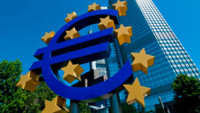 Although it’s still early, the foreign exchange markets seem to be stabilizing somewhat as the Easter holiday approaches. The US dollar’s weakness persists, raising questions about whether currency policy will be part of trade discussions led by Scott Bessent with Japan and South Korea, potentially mirroring a Mar-a-Lago agreement.
Although it’s still early, the foreign exchange markets seem to be stabilizing somewhat as the Easter holiday approaches. The US dollar’s weakness persists, raising questions about whether currency policy will be part of trade discussions led by Scott Bessent with Japan and South Korea, potentially mirroring a Mar-a-Lago agreement.
USD: Volatility Peaks Unsustainable EUR/USD and USD/JPY experienced a brief surge in implied volatility to 20% last week, an extreme level unlikely to last long without a global financial crisis. Fortunately, the financial system seems stable thus far, prompting a review of last week’s events.
US tariff policy remains volatile, exemplified by temporary tariff exemptions on some Chinese electronic exports, representing a significant portion of China’s exports to the US. The market anticipates potential actions against the semiconductor and pharmaceutical sectors.
The divergence between US yields and the dollar sparked discussions of the US resembling an “emerging market.” Historically, such divergences are rare and occur during periods of significant stress.
Last week’s heavy deleveraging in the US Treasury market, likely driven by the unwinding of basis trades, contributed to this divergence. It remains to be seen how long this negative correlation persists, barring further market disruptions.
A potential “Mar-a-Lago accord,” where Washington seeks currency agreements alongside tariffs, could influence global FX hedge ratios on US investments. Scott Bessent’s trade negotiations might involve FX deals to weaken USD/JPY and USD/KRW.
This week, expect market volatility driven by tariff news. US data may be strong, with March retail sales potentially boosted by pre-tariff spending. Federal Reserve speakers, particularly Christopher Waller and Jerome Powell, will be closely watched for signals on rate cuts or Treasury market intervention.
Buy-side dollar selling dominated last week, confirmed by CFTC futures data. The DXY index suffered significant technical damage, suggesting potential seller resistance around 100.50/75 if the bearish trend continues.
EUR: Establishing a New 1.12-1.15 EUR/USD Range EUR/USD broke out of a long-term bearish trend last week, establishing 1.11/1.12 as crucial support. The buy-side is likely to purchase EUR/USD on dips, awaiting the impact of tariffs on US data.
While tempting to “sell America,” claims of Chinese US Treasury sales are speculative. Fund flow data showed net positive flows into the long end of the US Treasury market, despite most flows targeting money market funds and the short end of the curve. March Treasury International Capital (TIC) data will be closely analyzed for Chinese selling.
EUR/USD may be range-bound due to a medium-term trend change indicating a US slowdown and a dovish European Central Bank. The ECB may be concerned about the trade-weighted euro’s surge, but will probably also acknowledge its advantages, its benefits and safe haven properties.
This benefits eurozone borrowing costs, with German 10-year Bunds outperforming Treasuries.
EUR/USD is overvalued based on short-term rate differentials. While a move to 1.15 is possible, a near-term range of 1.12-1.15 is more likely than an immediate surge to 1.18/20.
GBP: Macro Back in Focus This Week Sterling rose against the dollar but weakened against the euro, participating in the dollar’s de-rating as a reserve currency. However, greater euro liquidity and repatriation of financial assets into the eurozone, due to its trade surplus with the US, likely contributed to the decline against the euro.
This week, macro factors may drive sterling, focusing on labor market data and inflation, both presenting downside risks.
EUR/GBP might retest the 0.8730 high, but a dovish ECB could trigger a decline.












